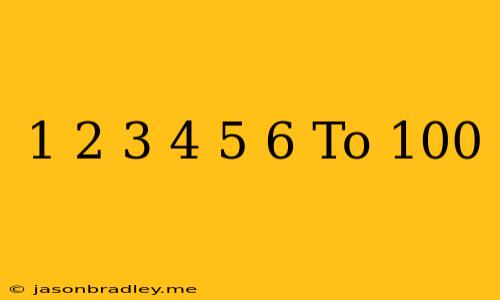The Fascinating World of Numbers 1 to 100
The seemingly simple sequence of numbers from 1 to 100 holds a surprising amount of mathematical beauty and intrigue. This seemingly simple set of numbers is the foundation for countless mathematical concepts and provides a platform for exploring various patterns, properties, and applications.
Exploring the Basics
The numbers 1 to 100 encompass the first hundred natural numbers, which are the positive whole numbers used for counting. Within this set, we can observe:
- Even numbers: 2, 4, 6, 8, ... , 100. These are divisible by 2.
- Odd numbers: 1, 3, 5, 7, ... , 99. These leave a remainder of 1 when divided by 2.
- Prime numbers: 2, 3, 5, 7, 11, 13, 17, 19, 23, 29, 31, 37, 41, 43, 47, 53, 59, 61, 67, 71, 73, 79, 83, 89, 97. These are only divisible by 1 and themselves.
Hidden Patterns and Properties
Beyond basic classification, the numbers 1 to 100 reveal intriguing patterns and properties:
- Sum of consecutive numbers: The sum of the first 100 natural numbers is 5050. This can be calculated using the formula: n(n+1)/2, where n = 100.
- Perfect squares: 1, 4, 9, 16, 25, 36, 49, 64, 81, 100. These are numbers obtained by squaring a whole number.
- Fibonacci sequence: This sequence is formed by adding the previous two numbers: 1, 1, 2, 3, 5, 8, 13, 21, 34, 55, 89.
- Digit sums: Interesting patterns emerge when you sum the digits of each number. For example, the digit sum of 12 is 3, while the digit sum of 99 is 18.
Applications and Significance
The numbers 1 to 100 are not merely academic curiosities. They have crucial applications in various fields:
- Counting and measurement: The basis for counting and measuring quantities.
- Computer science: Used in data storage, indexing, and algorithm design.
- Cryptography: Used for encryption and decryption methods.
- Statistics and probability: Essential for analyzing data and calculating probabilities.
Conclusion
The numbers 1 to 100, seemingly simple and mundane, hold a wealth of mathematical richness and profound applications. From basic classifications to complex patterns and properties, this set of numbers continues to fascinate mathematicians and serve as a foundation for countless areas of study and application.
